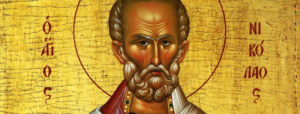By Pastor Stephen Hess –
If you asked most Americans what person or figure they most associate with Christmas, my guess is that St. Nicholas or Santa Claus (as he is more commonly known) would be the number one response. As a Christian, I find our cultural obsession with Santa Claus frustrating. For many Americans, the story of Santa and his reindeer has eclipsed the true story of Christmas—the birth of our Lord Jesus Christ. The great irony is that the real St. Nicholas would not have wanted the Christmas holiday to focus on him but on Jesus.
What do we know about the real St. Nicholas? Historians estimate that Nicholas was born around A.D. 280 in Patara, Asia Minor. Born into a Christian family, he showed unusual spiritual awareness and maturity from a young age. Nicholas later became bishop of Myra in modern-day Turkey, and hence he was referred to in the church as “Nicholas of Myra.” In later centuries miraculous stories were told about Nicholas, many of which were probably legends. There is a great deal that we do not know about the life of this early Christian leader. However, piecing together the historical evidence we do have, a few things seem clear.

First, Nicholas was a defender of truth. It appears that Nicholas was one of the bishops that attended the Council of Nicea. This council was called by the Emperor Constantine and met in 325 A.D. to discuss a number of theological controversies. The end result was the creation of the “Nicene Creed” which is still used in churches today. One of the primary controversies at the Council of Nicea concerned the doctrine of the Trinity. An early church leader named Arius had caused a great stir by arguing that Christ was not equal in essence to God the Father but was a creation or an offshoot of the Father. Numerous church leaders courageously opposed Arius, and this position was eventually condemned as heresy. Among these leaders was Nicholas, about whom one biographer wrote, “Thanks to the teaching of St. Nicholas, the metropolis of Myra alone was untouched by the filth of the Arian heresy, which it firmly rejected as a death-dealing poison.”
Second, Nicolas was an example of faithfulness. During his lifetime Christians suffered significant persecution under the Roman Emperor Diocletian. In 303 A.D. Diocletian issued an edict that ordered all copies of the Scriptures to be surrendered and burned, churches to be demolished, and Christians to cease from gathering for worship. The Romans often targeted Christian leaders in their persecution of the church, and Nicholas was arrested and imprisoned shortly after he became a bishop. During his imprisonment he was beaten, tortured, and pressured to renounced Christ. Nicholas stood firm in his faith and was later honored as a “confessor”—one who suffered torture for Christ but lived to tell about it.
Third, Nicholas was a giver of gifts. After Nicholas’s parents died, they left him a great fortune. According to one of his biographers, he sought guidance from the Lord about how to use his personal wealth. As theologian Adam English writes in his book The Saint Who Would Be Santa Claus, “Nicholas was wary of the temptation his inherence presented; it opened the gate to greed, worldly ambition, pride, gluttony, and self-destruction. He wondered what he should do to avoid such pitfalls.” After reflecting on the Scriptures and the Biblical call to help the poor, Nicholas gave most of his wealth away and became known as a generous giver of gifts. One of the most famous stories involved a father who became so destitute that he was going to sell his three daughters into prostitution to provide for his family. The story goes that after hearing of their plight, Nicholas secretly visited their house at night and threw a bag of gold coins through an open window. The family found the miraculous gift the next morning and wept with joy.
The history of how St. Nicholas gradually evolved into the figure we know today as “Santa Claus” is long and complex. As church history progressed, a feast day was established to honor St. Nicholas and Christians began celebrating this day by exchanging gifts. Over the centuries, stories about Nicholas were merged with various cultural legends and traditions. Eventually St. Nicholas would become “Santa Claus” in the United States, a figure based far more on the 1823 poem “Twas the Night Before Christmas” than on the historical Bishop of Myra. The great irony is that the real St. Nicholas would never have wanted the focus of Christmas to be upon him, but rather upon Christ. As Kevin DeYoung writes, “With what little we know about St. Nicholas, it is safe to say he would not be pleased to know he had eclipsed Christ in the hearts of many as the central figure of Christmas.”
Theologian Adam English describes the account of how in 295 A.D. the bishops were praying for the Lord’s guidance as to who should be the next bishop of Myra. As they prayed, one of the senior bishops received a vision: “Go to the house of God with the others this night and lie in wait in the atrium. Take the first person to enter and ordain him bishop. His name will be Nicholas.” The old bishop went to the church and encountered Nicholas in the early hours of the morning. When the Bishop asked him his name Nicholas responded, “Sir, I am the sinner Nicholas, a servant of your excellency.”
Like many stories about Nicholas, this account may be part legend, but it does illustrate an important fact about the real St. Nicholas: He was a man who knew he was a sinner and who trusted in Christ alone for his salvation. Consequently, I think it is undeniable that if Nicholas were alive today, he would want to point others not to himself but to Jesus, who should be the true focus of our Christmas celebration. After all, the good news of Christmas is not that a man in a red suit has come bringing gifts down a chimney, but that a child has been born and has brought the greatest gift of all to the world—the gift of salvation.
Perhaps as our neighbors put up their Santa decorations this year we can use it as an opportunity to ask them if they have ever heard about the real St. Nicholas, and in bringing up the real St. Nicholas, we can point others to Christ.

